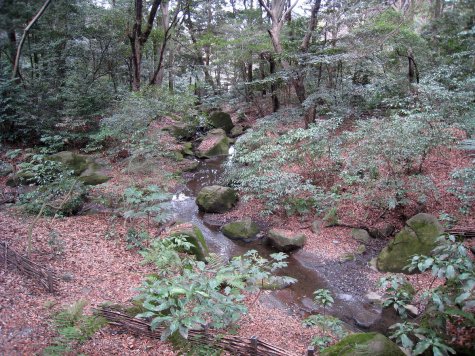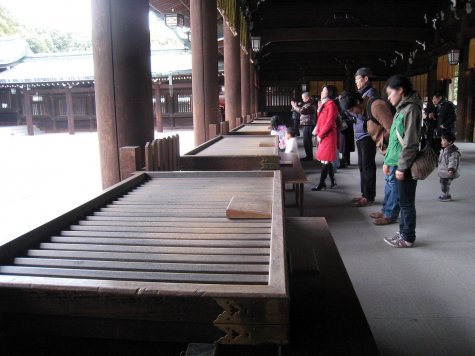I guess that Saturday afternoon is a good bet for families to visit the gardens.
As we entered the gardens walking north, I enjoyed the view of the brook to the side.
The park honours the Emperor Meji who passed away in 1912, and is interred in Kyoto. The view of the long, tree-covered walk is impressive.
Sake barrels are displayed as decorations, emptied from prior festivals after having been donated by local brewers.
The Meiji period was seen as enlightened one, when the emperor enjoyed western food and took wine with it. Wineries in Bourgogne, France, consecrated these barrels in the emperor’s honour.
At the end of that entry walk, a turn left brought us to to the torii (shrine gate).
Approaching the main shrine building is the covered fountain typical in temples.
As did other visitors, Marianne cleansed herself with the water.
A smaller torii marked the perimeter of the main temple.
Marianne took care to cross over the threshold into the main temple.
The courtyard is enclosed all the way around by buildings.
We were surprised and honoured to be just in time to watch a wedding procession
Everyone in the shrine stopped to admire the wedding group.
Marianne had forgotten to bring her camera, and was impressed by the embroidery on the back of this bright kimono.
After a brief pause for ceremony, the wedding party crossed the courtyard to another gate.
Through the gate, we saw them taking formal photos, presumably with extended family and friends.
We continued into the main temple, which had an internal courtyard.
Visitors made offerings at the altar.
On one side was a taiko drum, that might be used in a festival.
As we were about to leave, Marianne noticed the curtain tassels, commenting on their colour.
Outside the main shrine, we noticed the walls of votive tablets.
The gardens were no less grand, as we left.
I hadn’t noticed the detail of water flowing by the walk on the way in.
We had also crossed over an arched bridge on the way in. I guess that I was too focused on getting to the shrine on the approach!
Looking down from the arched bridge, only a small trickle of water was flowing in the stream.
The gardens are a tranquil oasis right beside one of the busiest train stations in Tokyo. We wouldn’t have known it was there!
The shrine and garden were constructed in the honour of the Emperor Meiji, who I’ve now learned ushered in modern Japan.
[Start a large-image lightbox screen show over this blog post (in a supported browser)]





























